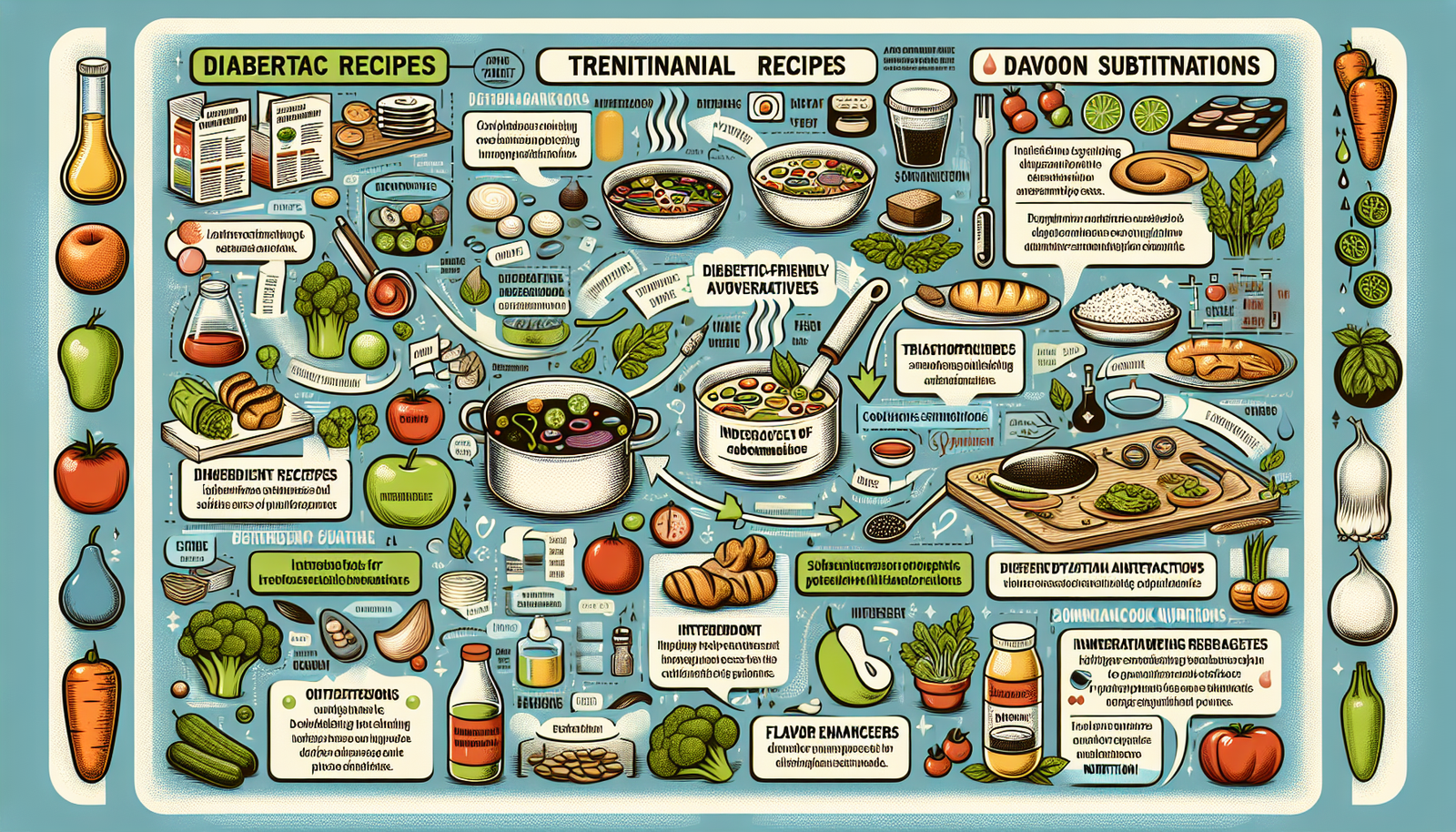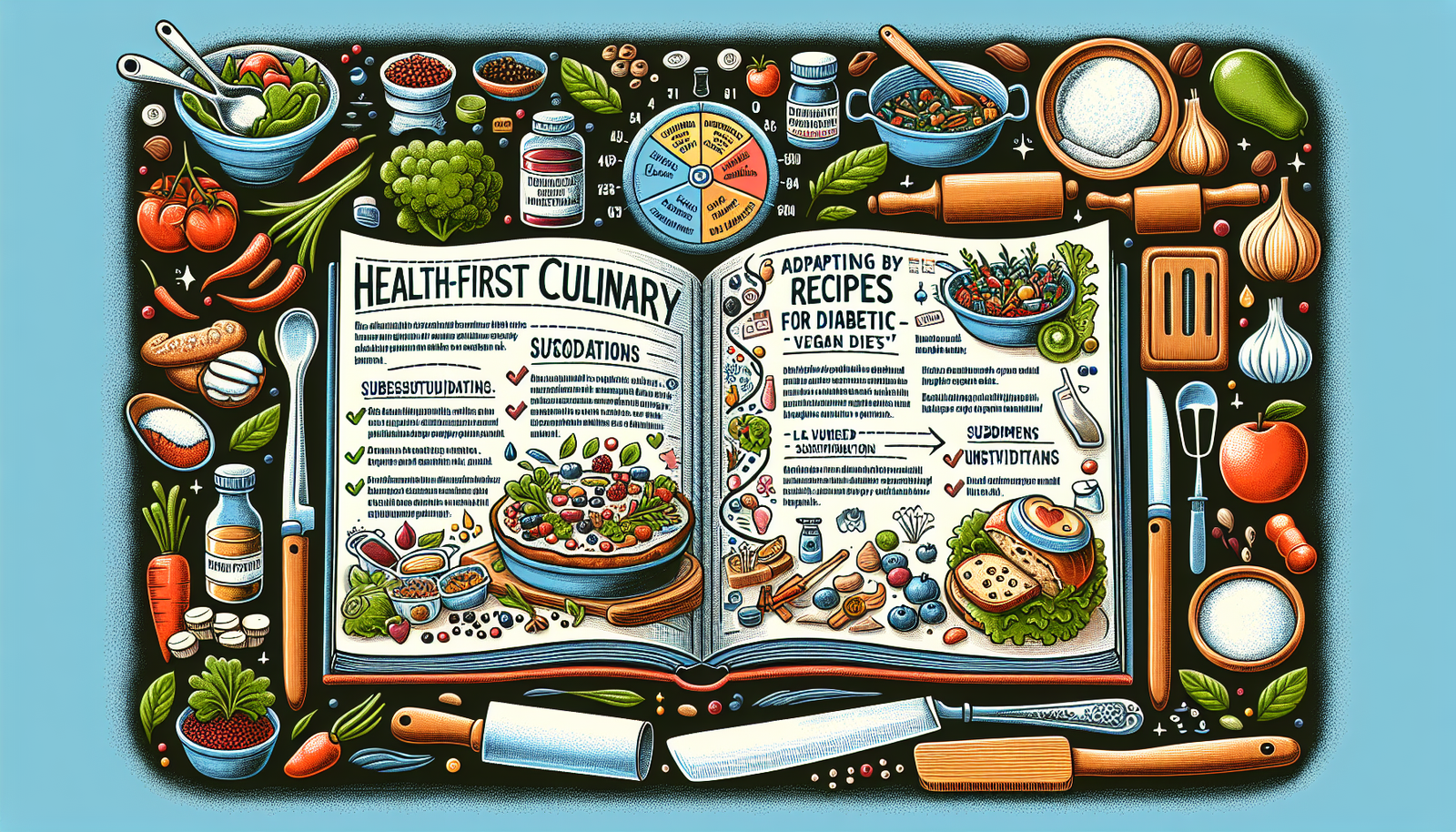In this article, you will discover practical tips on how to transform your favorite traditional recipes into diabetic-friendly and vegan alternatives. These simple modifications will allow you to satisfy your cravings without compromising your health or ethical beliefs. Whether it’s decadent desserts or savory comfort foods, you’ll learn how to make small adjustments that won’t sacrifice flavor or texture. Get ready to embark on a culinary adventure that caters to your dietary needs, all while preserving the essence of beloved family recipes.

Understanding Diabetic-Friendly and Vegan Diets
When it comes to maintaining a healthy lifestyle, diet plays a crucial role. For individuals with specific dietary needs, such as diabetes or following a vegan lifestyle, modifying traditional recipes becomes essential. Understanding what a diabetic-friendly diet and a vegan diet entail is the first step towards successfully adapting recipes.
What is a Diabetic-Friendly Diet?
A diabetic-friendly diet is designed to help individuals with diabetes manage their blood sugar levels. It focuses on controlling the intake of carbohydrates and sugars, as these can cause rapid spikes in blood sugar levels. A diabetic-friendly diet typically includes whole grains, lean proteins, and healthy fats while limiting refined sugars, processed foods, and high-glycemic index foods. By making smart choices and monitoring portion sizes, individuals with diabetes can enjoy a wide variety of nutritious and delicious meals.
What is a Vegan Diet?
A vegan diet, on the other hand, is a plant-based diet that excludes all forms of animal products, including meat, dairy, eggs, and honey. It prioritizes fruits, vegetables, whole grains, legumes, nuts, and seeds. A vegan diet is not only beneficial for animal welfare and the environment but also offers numerous health benefits. It is rich in fiber, vitamins, minerals, and antioxidants, while often being lower in saturated fat and cholesterol.
Key Considerations for Modifying Traditional Recipes
When it comes to modifying traditional recipes to fit a diabetic-friendly or vegan diet, there are several key considerations to keep in mind. These considerations will help ensure that the modified recipes are both healthy and flavorful.
Identifying Problematic Ingredients
The first step in modifying a traditional recipe is identifying the ingredients that need to be substituted or eliminated. For a diabetic-friendly diet, this includes avoiding or reducing the amounts of added sugars, refined flours, and unhealthy fats. Vegans, on the other hand, need to identify and replace animal-based ingredients like meat, dairy, and eggs.
Substituting Sweeteners and Fats
To make a recipe diabetic-friendly, traditional sweeteners like granulated sugar or honey can be replaced with natural alternatives like stevia, erythritol, or monk fruit. These sweeteners do not raise blood sugar levels and provide the desired sweetness. When it comes to fats, swapping unhealthy saturated fats with healthier alternatives like olive oil, avocado oil, or coconut oil is advisable.
Balancing Nutritional Needs
While modifying a recipe, it is vital to ensure that the nutritional needs of the specific dietary requirement are met. For individuals with diabetes, this means keeping a close eye on carbohydrate content and ensuring meals include a balance of lean proteins, healthy fats, and fiber-rich foods. For vegans, maintaining a varied and diverse diet is crucial to obtain essential nutrients like iron, calcium, vitamin B12, and omega-3 fatty acids.
Recipe Modifications for Diabetic-Friendly and Vegan Cooking
Now that we’ve covered the key considerations, let’s explore some specific recipe modifications for diabetic-friendly and vegan cooking.
Substituting Animal-Based Ingredients
When it comes to vegan cooking, there are several options for substituting animal-based ingredients. Meat can be replaced with plant-based proteins like tofu, tempeh, seitan, or legumes. Dairy can be substituted with non-dairy alternatives such as almond milk, soy milk, or coconut milk. Eggs can be swapped with ingredients like flax eggs, applesauce, or mashed bananas, depending on the recipe.
Replacing White Flour and Other High-Glycemic Flours
White flour and other high-glycemic flours can be problematic for individuals with diabetes as they can cause blood sugar levels to spike. Thankfully, there are healthier alternatives available. Whole wheat flour, almond flour, coconut flour, oat flour, or a combination of these can be used to replace white flour in recipes. These alternatives not only have a lower glycemic index but also provide added nutritional benefits.
Using Low-Glycemic Sweeteners
For individuals with diabetes, traditional sweeteners like sugar and honey are best avoided. Low-glycemic sweeteners like stevia, erythritol, and monk fruit are excellent alternatives as they do not significantly impact blood sugar levels. These sweeteners can be used in baking or added to beverages and desserts to provide the desired sweetness without the sugar rush.
Modifying Breakfast Recipes
Breakfast is often considered the most important meal of the day, and with these recipe modifications, individuals can enjoy a healthy and satisfying start to their mornings.
Making Vegan Pancakes
Traditional pancake recipes can easily be modified to be vegan-friendly. Instead of using dairy milk and eggs, plant-based milk (such as almond milk or soy milk) and either flax eggs or applesauce can be used. The result is a fluffy and delicious pancake that is completely free of animal products.
Creating Diabetic-Friendly Oatmeal
Oatmeal is a popular breakfast choice, but it can be high in carbohydrates. To make it more diabetic-friendly, opt for steel-cut oats or rolled oats, which have a lower glycemic index compared to instant oats. Additionally, adding a source of protein such as nuts or seeds, along with a small amount of low-glycemic sweeteners like cinnamon or berries, can help balance blood sugar levels.
Adapting Traditional Egg Dishes
Eggs are a staple in many breakfast dishes, but they can easily be replaced to accommodate a vegan diet. Tofu scrambles are a fantastic alternative, providing a similar texture and taste. By seasoning the tofu with turmeric, nutritional yeast, and other spices, one can create a flavorful and protein-rich scramble that rivals traditional scrambled eggs.

Adapting Lunch and Dinner Recipes
Lunch and dinner are important meals that can be modified to be both diabetic-friendly and vegan. With some simple tweaks, traditional recipes can be transformed into healthy and satisfying meals.
Veganizing Soups and Stews
Soups and stews are a beloved comfort food but often rely heavily on meat-based broths or stocks. To veganize these recipes, simply swap out the meat-based broth for vegetable broth. Additionally, instead of using meat, add hearty vegetables, legumes, or plant-based proteins to create a filling and nutritious meal.
Transforming Classic Sandwiches
Sandwiches are a lunchtime favorite, but traditional options often include animal-based ingredients like deli meats, cheese, and mayo. By choosing plant-based proteins such as tempeh, tofu, or seitan and swapping dairy cheese and mayo with vegan alternatives, you can create a delicious and satisfying vegan sandwich.
Modifying Pasta Dishes
Pasta dishes can easily be modified to fit both a vegan and diabetic-friendly diet. Opting for whole wheat or gluten-free pasta varieties can provide a healthier option than traditional white pasta. To add flavor and texture, incorporate an array of vegetables, plant-based proteins, and a homemade tomato sauce free of added sugars and unhealthy fats.
Customizing Snack and Dessert Recipes
Snacks and desserts are often the most challenging recipes to modify. However, with a bit of creativity and the right ingredients, delicious and healthy options can be enjoyed guilt-free.
Baking Vegan Cookies
Who doesn’t love a freshly baked cookie? To make them vegan, dairy-based ingredients like butter and eggs can be replaced with coconut oil or plant-based margarine and flax eggs. Additionally, using alternatives like almond flour or oat flour instead of white flour and sweetening with low-glycemic sweeteners ensures that these cookies can still be enjoyed by those following a diabetic-friendly diet.
Crafting Diabetic-Friendly Snack Bars
Snack bars are a convenient option for a quick energy boost, but many store-bought options are loaded with sugar and unhealthy fats. By making your own snack bars, you have control over the ingredients. Try using a combination of nuts, seeds, whole grains, and low-glycemic sweeteners like dates or dried fruits to create a delicious and healthy snack bar that is suitable for individuals with diabetes.
Creating Plant-Based Puddings
While traditional puddings are typically made with dairy and refined sugars, plant-based puddings offer a healthier alternative. By using ingredients like avocados, bananas, or coconut milk as the base, combined with natural sweeteners like maple syrup or dates, one can create a creamy and satisfying dessert that is both vegan and suitable for those managing diabetes.

Tips for Successful Modifications
Modifying recipes to be both diabetic-friendly and vegan can be both challenging and rewarding. Here are a few tips to ensure successful modifications every time:
Gradual Recipe Adaptation
Rather than completely overhauling a recipe, start by making small modifications and gradually adjust the ingredients as needed. This will allow you to assess the impact on taste and texture while maintaining the essence of the original recipe.
Experimenting with Flavors and Textures
Don’t be afraid to get creative with flavors and textures. Explore different herbs, spices, marinades, and sauces to add depth and complexity to your modified recipes. Experimentation is the key to discovering new and exciting dishes that suit your dietary needs.
Seeking Expert Advice
If you’re uncertain about certain ingredients or modifications, don’t hesitate to seek advice from nutritionists, dieticians, or experienced chefs. They can provide valuable insights and guidance to help you navigate the world of diabetic-friendly and vegan cooking.
Conclusion
Modifying traditional recipes to be both diabetic-friendly and vegan may require some initial effort and experimentation, but the rewards are well worth it. By understanding the principles of these dietary requirements and making thoughtful ingredient substitutions, individuals can enjoy a wide variety of delicious and nutritious meals. With a little creativity, it’s possible to transform any recipe into a diabetic-friendly and vegan delight. So go ahead and embark on this culinary adventure, knowing that you’re nourishing your body while embracing a compassionate and sustainable lifestyle.


